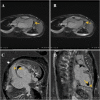Case report: Application of non-VKA oral anticoagulants in patient of idiopathic hypereosinophilic syndrome with intracardiac thrombus
- PMID: 36199682
- PMCID: PMC9529005
- DOI: 10.3389/fphar.2022.1018394
Case report: Application of non-VKA oral anticoagulants in patient of idiopathic hypereosinophilic syndrome with intracardiac thrombus
Abstract
Idiopathic hypereosinophilic syndrome (IHES) is a rare but life-threatening disease related to a group of myeloproliferative disorders characterized by prolonged eosinophilia of unknown cause and inflammatory damage to multiple organs. Here, we present a 44-year-old female patient complaining of shortness of breath and palpitations for 1 month. Her history and presentation were unremarkable, except for a 3-years history of rheumatoid arthritis treated with ibuprofen (0.3 g per day). Initial examination showed heart rate (HR) 120 bpm, respiratory rate (RR) 20 bpm, temperature (T) 36°C, blood pressure (BP) 130/70 mmHg, ventricular gallop rhythm, rales at the lung bases, soft abdomen, nonpalpable liver and spleen, and slight edema in both lower extremities. Bone marrow aspirate and biopsy confirmed the diagnosis of IHES, while cardiac MRI showed intracardiac thrombus. The symptoms of shortness of breath and palpitation disappeared, the eosinophil counts in routine blood tests were normal, and the thrombus in the cardiac cavity gradually disappeared after combined therapy of anti-hypereosinophilic, anti-coagulant and anti-heart failure treatments.
Keywords: case report; heart failure; idiopathic hypereosinophilic syndrome; intracardiac thrombus; non-VKA oral anticoagulants; shortness of breath.
Copyright © 2022 Zou, Liu and Li.
Conflict of interest statement
The authors declare that the research was conducted in the absence of any commercial or financial relationships that could be construed as a potential conflict of interest.
Figures



Similar articles
-
Idiopathic hypereosinophilic syndrome associated with rapid progression of cardiac, pulmonary and skin infiltration.Cardiovasc J Afr. 2020 Sep/Oct;31(5):274-280. doi: 10.5830/CVJA-2020-009. Epub 2020 Jun 12. Cardiovasc J Afr. 2020. PMID: 32555925 Review.
-
Loeffler endocarditis with intracardiac thrombus: case report and literature review.BMC Cardiovasc Disord. 2021 Dec 28;21(1):615. doi: 10.1186/s12872-021-02443-2. BMC Cardiovasc Disord. 2021. PMID: 34961478 Free PMC article.
-
Idiopathic hypereosinophilic syndrome with intracardiac atypical linear-shaped and floating thrombus presenting as embolic cerebral infarction.J Cardiol Cases. 2020 Nov 26;23(5):193-197. doi: 10.1016/j.jccase.2020.10.015. eCollection 2021 May. J Cardiol Cases. 2020. PMID: 33995694 Free PMC article.
-
Acute progressive stroke with middle cerebral artery occlusion caused by idiopathic hypereosinophilic syndrome: a case report.BMC Neurol. 2020 Oct 1;20(1):361. doi: 10.1186/s12883-020-01941-8. BMC Neurol. 2020. PMID: 33003998 Free PMC article.
-
[Mitral valve replacement in idiopathic hypereosinophilic syndrome].Nihon Kyobu Geka Gakkai Zasshi. 1991 Nov;39(11):2068-73. Nihon Kyobu Geka Gakkai Zasshi. 1991. PMID: 1774488 Japanese.
Cited by
-
FIP1L1-PDGFRA Clonal Hypereosinophilic Syndrome With Eosinophilic Myocarditis and Intracardiac Thrombus.Cureus. 2023 Aug 8;15(8):e43138. doi: 10.7759/cureus.43138. eCollection 2023 Aug. Cureus. 2023. PMID: 37692703 Free PMC article.
-
Hypereosinophilia and Left Ventricular Thrombus: A Case Report and Literature Review.Cureus. 2024 Jun 4;16(6):e61674. doi: 10.7759/cureus.61674. eCollection 2024 Jun. Cureus. 2024. PMID: 38966441 Free PMC article.
References
Publication types
LinkOut - more resources
Full Text Sources

